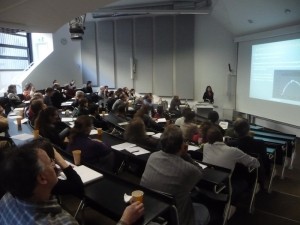Science Day at ESO

Archaeoastronomy: reconnecting to reality. Part II
February 2, 2010
Willi Benz talks about extra-solar planets at ESO
February 26, 2010The staff of the European Organization for Astronomical Research (ESO) includes people coming from very different fields. Given the fact that we design, build and operate telescopes and instruments, our teams are composed by a mixture of mechanical, optical, electronic and software engineers plus, of course, some astrophysicists. These have a double life within the organization, since they do functional work for the organization, but also their own research (up to 50% of their working time). The purpose of this is rather clear: if the organization wishes to keep scientifically linked to the community it is serving, than at least a fraction of its staff must be active in research. By construction, since ESO is not a university, there are no large scientific groups and most of us are part of large international collaborations. Also (and this is done on purpose), the scientific staff of ESO covers a wide spectrum of astrophysical fields, so that within the organization is rather rare to have two people working on the same subject.
Exactly because of this, it often happens than one does not exactly know what the guy sitting in the next office is doing in her/his science time. With the purpose of reducing this potential problem and to stimulate possible collaborations within the staff, the Office for Science at ESO organizes every year the so called Science Day, where everybody is given the opportunity of telling the others what she is doing. And this is what happened yesterday. The overall organization has been growing significantly during the last ten years, so that now what we call the ESO Faculty includes more than 80 scientists, ranging from PhD students to full astronomers. So, in order to fit more than 80 talks in about 8 hours, we were given 4+1 minutes for our presentations. The sessions were chaired by some of our post-doc Fellows.
It is always amazing to see how many different and interesting topics one can work on in astrophysics (I guess the same is true, though, for any other scientific discipline). We heard about the contribution of comets to the content of water on Earth, methane on Mars, very old stars in the Galaxy, stellar seismology, optical interferometry… you name them.
Besides giving old farts the chance to see what the youngsters are doing and where astrophysics is moving to, it was also a good opportunity for the young researchers to get familiar with presenting their work in front of a large audience. An exercise which might turn to be very useful for their future careers. Well done, lads.


